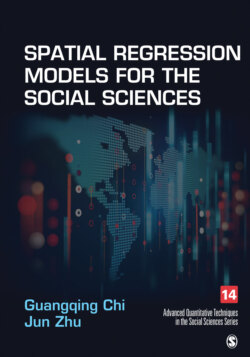Читать книгу Spatial Regression Models for the Social Sciences - Jun Zhu - Страница 19
1.3.3 Minor Civil Division (MCD): The Spatial Unit of Analysis
ОглавлениеMCDs are designated on the basis of legal entities rather than on population sizes and are recognized in twenty-eight U.S. states. Each MCD (a city, a village, or a town) is a functioning governmental unit with elected officials who provide services and raise revenues. The particular data set to be analyzed in our case study consists of 1,837 adjusted MCDs in Wisconsin. Wisconsin has seventy-two counties, and the MCDs are county subdivisions. They are exhaustive political territories that are mutually exclusive and nonnested. Wisconsin is composed of some large cities and surrounding neighboring suburbs; multiple small villages, towns, and cities; and low-density rural areas. It is therefore a typical MCD state.
In Wisconsin from 1970 to 2010, the MCD boundaries were unstable—over time, boundaries of existing MCDs shift, new MCDs are created, former MCDs disappear, the names of MCDs change, and the jurisdictional statuses of the MCDs change (e.g., towns become villages and villages become cities). Changes such as these required that we adjust the data to establish a data set that is spatially consistent over time. We applied three rules: new MCDs are merged into the original MCDs from which they emerged; disappearing MCD problems are solved by dissolving the original MCDs into their current “home” MCDs; and occasionally, several distinct MCDs are dissolved into one super-MCD. The adjustments resulted in a data set of 1,837 MCDs. Among these, the sizes of the MCDs range from 0.1 to 368 square miles, with an average size of 29.6 square miles. In 2010, the populations of MCDs ranged from 40 to 594,833 persons, with an average population of 3,097 persons.
For the purpose of illustrating spatial regression models dealing with spatial heterogeneity, in Sections 5.1 and 5.2, we further classify the MCDs into rural, suburban, and urban areas. Many classifications of rural, suburban, and urban areas have been used in existing research, and a single, standard classification does not exist (Chi, 2012). Our classification in this book is based on the 2000 Census Urban Areas and 2000 Metropolitan and Micropolitan Statistical Areas (MMSAs) defined by the U.S. Office of Management and Budget. Our classification system consists of the following: MCDs that fall into the Census Urban Areas we call urban areas, MCDs that fall into the MMSAs but not into the Census Urban Areas we call suburban areas, and MCDs that fall out of both the MMSAs and the Census Urban Areas we call rural areas (Figure 1.3). This categorization may be useful for evaluation purposes but does not necessarily accurately reflect the actual conditions in Wisconsin.
Description
Figure 1.3 ⬢ The classification of rural, suburban, and urban MCDs in Wisconsin
Source: Chi (2012).
Studying population change at the MCD level has two advantages. The first one is the relevance of MCDs to planning and public policy making. In most parts of Wisconsin, census tracts have average sizes similar to MCDs and may serve as an alternative spatial unit of analysis. However, census tracts are geographic units delineated by the U.S. Census Bureau and do not have specific political or social meanings. MCDs, on the other hand, are functioning governmental units. The second advantage is that studying population change at subcounty levels, such as the MCD level, can provide insights into possible local dynamics that may not be captured by analysis at the county level or higher. For example, changes in transportation accessibility may not have major impacts on population change at county levels or higher, but they may have great impacts at subcounty levels. The changes may offset each other when the local changes are aggregated from small areas to larger ones. The scale effect, as this phenomenon is known (Fotheringham & Wong, 1991), would be more obvious in an urban area, which has one or a few counties divided into several MCDs. An example from the existing literature is research revealing that highway expansion/construction may benefit neighborhoods a few blocks away from the work but might be unpleasant to those in the neighborhoods nearby (Chi & Parisi, 2011). Airport expansion is a similar situation, with the work benefiting areas not too far away but being unpleasant in nearby areas. In both cases, the neighborhoods that are not immediate would experience less population loss and potentially higher population growth than the immediate neighborhoods, but in the county as a whole, the total population change would not be affected much by the internal migration due to these situations. Using MCDs instead of counties or census tracts as the unit of measure can show such subtle changes in the associations of various variables with population change and provide insight for policy makers in the affected neighborhoods.
